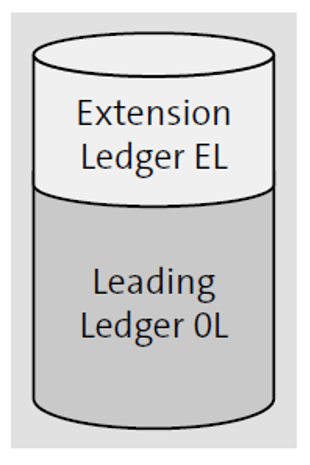For some functionalities in margin analysis with SAP S/4HANA, you’ll need an extension ledger to store predictive data.
An extension ledger sits on top of a ledger, as shown in the figure below.

Let’s consider an example: When you post a document in leading ledger 0L, it won’t be posted in extension ledger EL. Likewise, when you post a document in extension ledger EL, it won’t be posted in leading ledger 0L. When you run a P&L and balance sheet report for leading ledger 0L, you’ll only see documents that are posted in leading ledger 0L; however, when you run a P&L and balance sheet report for extension ledger 0L, you’ll see both postings from leading ledger 0L and extension ledger 0L. All non-generally accepted accounting principles (GAAP)–relevant postings occur in extension ledger 0L. Anything GAAP-relevant will be posted in leading ledger 0L. There is a strict separation of these two ledgers.
An extension ledger can’t live on its own; it always references a standard ledger. The extension ledger inherits the basic settings of the underlying ledger, such as assigned currency types. Let’s see how extension ledgers are created.
Create an Extension Ledger
Extension ledgers are created in financial accounting via the configuration path: Financial Accounting > Financial Accounting Global Settings > Ledgers > Ledger > Define Settings for Ledgers and Currency Types. By pressing F5, you can create an extension ledger, as shown in the next figure.

For this example, we created extension ledger EL by maintaining the following criteria:
Ledger Name
Enter the name of the ledger. The name has two characteristics (for this example, extension ledger EL).
Leading
If you are creating a leading ledger you need to check the checkbox in this column.
Ledger Type
Choose from two ledger types. One is a standard leger, which stands alone, for example, 0L or LC for local accounting. The other is an extension ledger, or one that references a standard ledger (chosen for this example).
- ExtLdgrTyp: Defines how the extension ledger can be used. To use the extension ledger for predictive accounting in margin analysis, choose Line items with technical numbers/no deletion possible.
- Underlying Ledger: Defines which standard ledger the extension ledger is referencing (in this example, ledger 0L is the reference ledger).
- Man.Pstgs Not Allwd: Select this checkbox to prevent the extension ledger from accepting manual postings. This setting isn’t mandatory for using predictive accounting in margin analysis. It’s selected in this example to make sure that all data in the extension ledger is derived from transactions in SAP S/4HANA and that there are no accruals or predictions entered manually.
- AcctgPrinc of Ledger: The accounting principle of the ledger specifies which accounting principle the ledger is assigned to. All company codes assigned to the extension ledger EL will be assigned to the same accounting principle. In our example, we assign the Extension Ledger to the accounting principle USAP (Local GAAP for USA), which is the same accounting principle the ledger 0L is assigned to.
Company Code Settings in an Extension Ledger
After creating the extension ledger, you need to check the company code settings. In the Dialog Structure on the left side of the screen shown in the next figure, open the Company Code Settings for the Ledger folder. Because the reference ledger for the extension ledger is ledger 0L, the extension ledger is automatically assigned to all company codes in the system that have ledger 0L. Therefore, you don’t have to do anything except check that company code 2000 has an entry for Ledger EL.

Check the Prediction Ledger
Before you can use the extension ledger in margin analysis, you need to define it as a prediction ledger by following the configuration path Financial Accounting > Predictive Accounting > Check Prediction Ledger. Press (F5) or click New Entries to assign the extension ledger EL in the figure below as the prediction ledger. Only if the extension ledger is created correctly will you be able to assign it as a prediction ledger for margin analysis. You can also define the extension ledger as Relevant for Commitment Management, but this can only be activated for one extension ledger, not multiple.

Now that you have an extension ledger set up, you can use predictive accounting in margin analysis with SAP S/4HANA Finance.
Learn Margin Analysis in Our Rheinwerk Course!
Your deep-dive into margin analysis (formerly known as account-based profitability analysis) with SAP S/4HANA! Master value flows from sales and distribution, financial accounting, materials management, and controlling. Optimize reporting using summary reports, line-item reports, and SAP Fiori apps! Get access to course recordings by clicking the banner below.
Editor’s note: This post has been adapted from a section of the book Profitability Analysis with SAP S/4HANA by Kathrin Schmalzing.
This post was originally published 1/2021 and updated 9/2025.




Comments